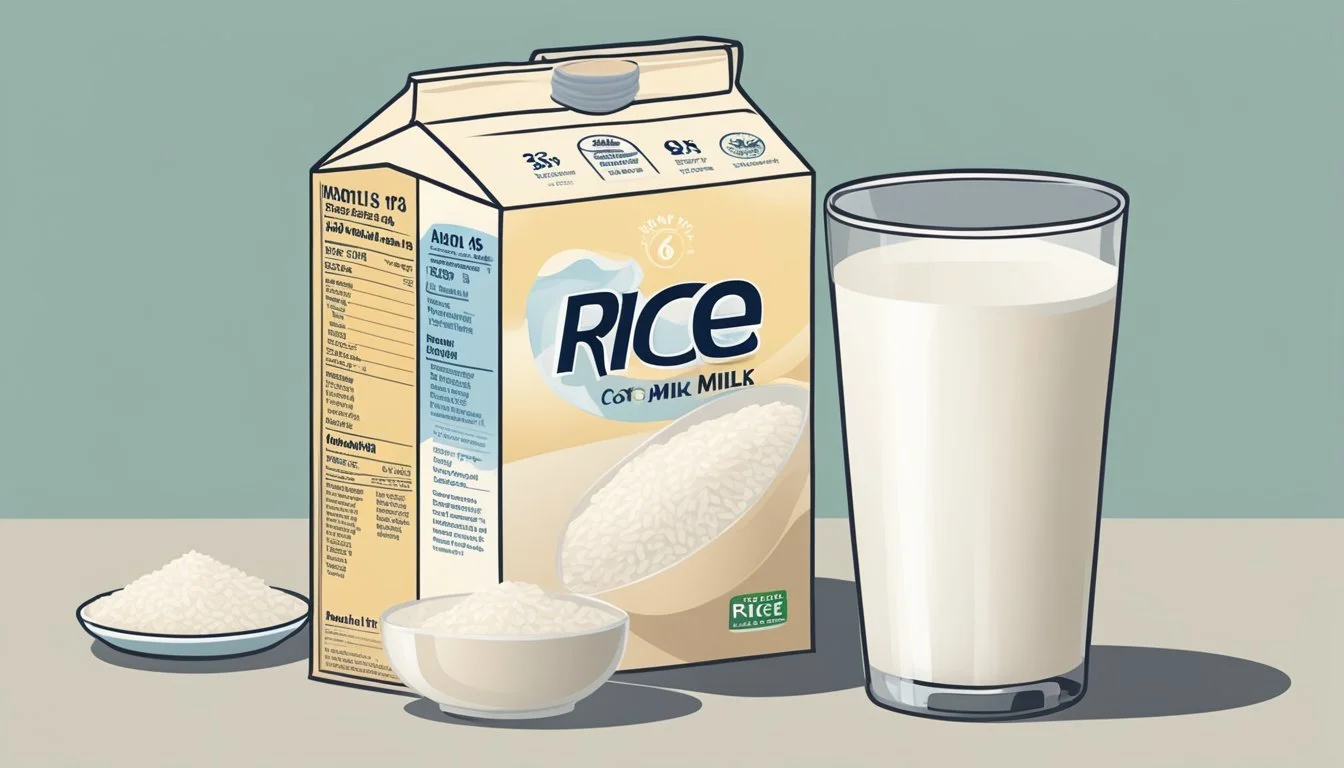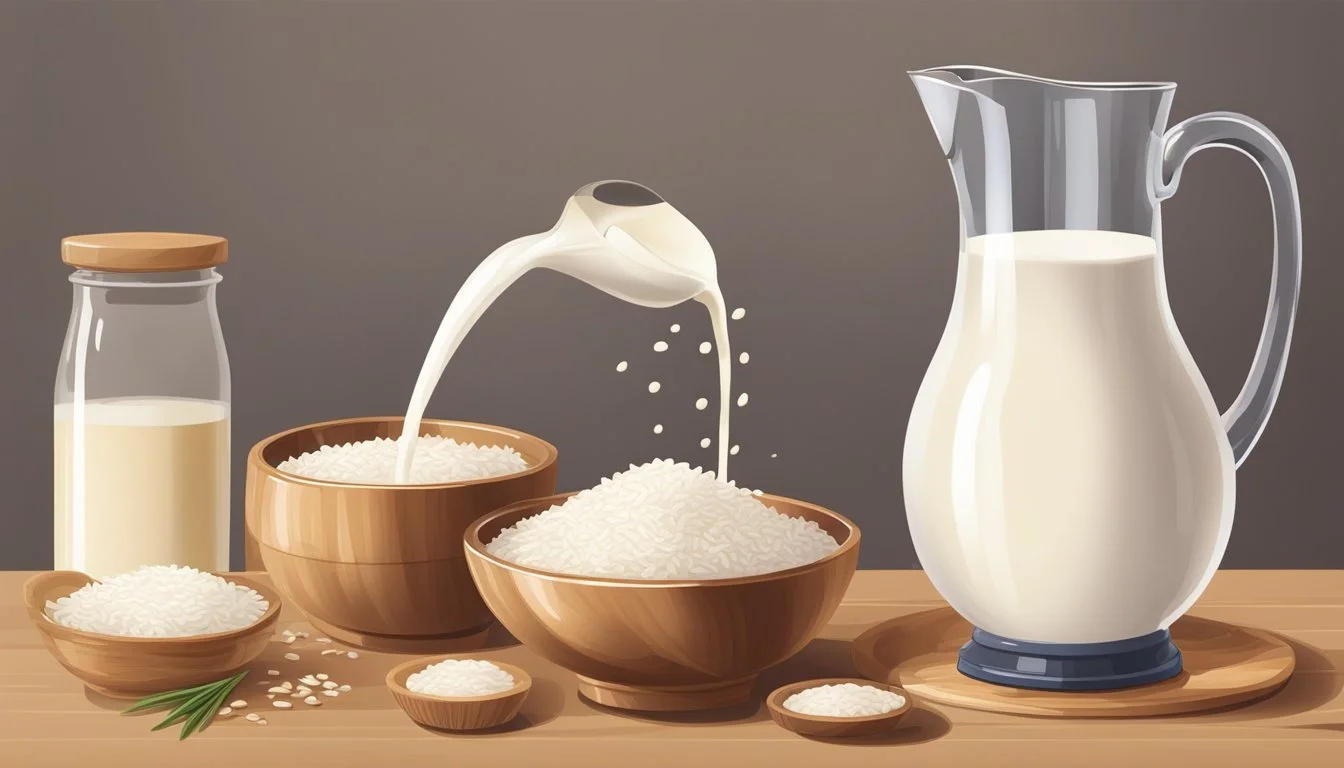How to Substitute Rice Milk for Cow's Milk
A Simple Guide for Dairy-Free Alternatives
Rice milk emerges as a popular dairy-free alternative to cow's milk, suitable for those with lactose intolerance, milk allergies, or dietary preferences such as veganism. As a plant-based milk, it is derived from milled rice and water and sometimes supplemented with vitamins and minerals to match the nutrient profile of cow's milk more closely. It is naturally sweeter, with a lighter consistency compared to its dairy counterpart.
When considering rice milk as a substitute in various recipes and uses, it's important to understand its flavor and nutritional profile. Rice milk typically contains more carbohydrates but less protein and fat than cow's milk. This difference influences not just the taste but also how rice milk performs in cooking and baking. It functions well in both savory and sweet dishes, and can often be used in a 1:1 ratio for cow's milk, though results may vary slightly due to its distinct properties.
Despite its differences, rice milk can be a versatile and health-conscious option in the kitchen. It offers a low-calorie and hypoallergenic alternative for pouring over cereal, adding to coffee, or using in smoothies and soups. Selecting the unsweetened versions of rice milk can cater to those monitoring their sugar intake, while fortification with calcium and vitamin D ensures that nutritional needs are still being met in the absence of cow's milk.
Benefits and Considerations
When substituting rice milk for cow's milk, it's important to consider the nutritional content, the suitability for various dietary restrictions, and the environmental impact. Making an informed choice can help ensure the substitution meets one's dietary needs and aligns with personal values.
Nutritional Differences
Rice Milk:
Calories: Lower than cow's milk.
Carbohydrates: Higher, mostly from sugars.
Protein: Significantly lower; generally 1g per serving.
Fat: Minimal amounts, around 1%.
Fortified versions: Often contain added calcium, vitamin A, and vitamin D.
Cow's Milk:
Calories: Higher; whole milk is about 150 calories per cup.
Carbohydrates: Similar to rice milk in terms of levels.
Protein: Richer, important for muscle repair and growth.
Fat: Contains saturated fats, which should be consumed in moderation.
Cholesterol: Present, which can be a consideration for those monitoring their intake.
Dietary Restrictions Compatibility
Substituting rice milk for cow's milk can be particularly beneficial for individuals with specific dietary restrictions:
Vegan diet: Rice milk is suitable as it is plant-based and contains no animal byproducts.
Lactose intolerance: Ideal for those who cannot digest lactose, a sugar found in cow's milk.
Allergic considerations: Cow's milk is a common allergen, whereas rice milk typically has a lower allergenic profile.
Environmental Impact
Considering the environmental impact of milk choices is becoming increasingly important:
Cow's Milk: Production has a higher environmental footprint, including higher water usage and greenhouse gas emissions.
Rice Milk: Typically has a lower environmental impact, but water use is still significant due to the nature of rice cultivation. It is considered a more eco-friendly alternative to cow's milk.
Culinary Uses
Rice milk's relatively neutral flavor and thin consistency make it a versatile substitute for cow's milk in various culinary applications. It is particularly suitable for those with allergies or intolerances to dairy, soy, or nuts.
Baking
In baking, the user can replace cow's milk with rice milk on a one-to-one basis for most recipes. This includes cakes, cookies, and muffins, where rice milk imparts a slight sweetness. The baker may need to adjust the quantity of sweeteners used in the recipe. For yeast breads, however, they should monitor the dough's consistency more closely as rice milk's lower protein content could affect the final product.
Cooking Savory Dishes
For savory dishes, chefs can incorporate rice milk as a dairy substitute without significantly altering the flavor profile. Dishes that require a lighter consistency, such as vegetable stir-fries or pasta dishes, benefit from rice milk's neutral taste. It should be noted that rice milk will not thicken as much as cow's milk, so adjustments with thickeners like flour or starch may be necessary.
Dairy-based Sauces and Soups
When preparing dairy-based sauces and soups, rice milk serves well as an alternative to cow's milk to create a smooth and velvety texture. Whether it's a béchamel sauce for lasagna or a creamy broth, rice milk can seamlessly blend in without contributing any overpowering taste. Chefs may need to reduce the sauce or soup for a slightly longer duration to reach the desired consistency due to rice milk's lower fat content.
Substituting in Recipes
When substituting rice milk for cow's milk, cooks should consider the recipe's need for the fat, protein, and sweetness levels cow's milk provides.
Beverage Recipes
For simple beverage recipes such as smoothies or milk-based drinks, rice milk can be used as a one-to-one substitute for cow's milk. However, because rice milk is naturally sweeter and thinner, adjustments to the sweetness and texture may be necessary.
Use unsweetened rice milk to maintain flavor balance.
To replicate the creaminess of full-fat cow's milk, blend in a small amount of nut butter or avocado.
Creamy and Sweet Recipes
In recipes that require a creamy texture or sweetness, rice milk's lower protein and fat content compared to cow's milk means it may not behave as expected.
For sauces or soups, use a thickening agent like flour or cornstarch.
Choose commercial rice milk brands fortified with calcium and vitamins for added nutritional value.
Baking:
Rice milk can replace cow's milk in a 1:1 ratio, but the final product may lack structure.
When baking sweets, reducing rice milk first can concentrate the flavor and compensate for extra liquid.
Substitutions for Specific Dairy Products
Rice milk can also substitute for specific dairy products in recipes, with some considerations for texture and flavor.
Yogurt:
Thicken rice milk with a starter culture and thickening agents for homemade dairy-free yogurt.
Mix rice milk with a small amount of vinegar or lemon juice to achieve the acidity needed for buttermilk.
Substitutes for Rice Milk:
For those who may not prefer rice milk or need alternatives, almond milk, soy milk, or oat milk can serve as substitutes.
Almond milk offers a nutty flavor and is commonly available in both sweetened and unsweetened varieties.
Soy milk closely mimics the protein content of cow's milk and is suitable for baked goods.
By following these guidelines, cooks can successfully integrate rice milk into various recipes, creating delightful dishes that cater to different dietary needs.
Making Homemade Rice Milk
Homemade rice milk is a simple and straightforward alternative to cow's milk, providing versatility and a plant-based option for those looking to avoid dairy. Preparing rice milk at home involves only a few steps:
Ingredients: Start with rice—either brown or white can be used. Brown rice is typically selected for its higher nutrient content, but white rice will also work. Gather clean water, which will be combined with the cooked rice (how long does cooked rice last?). Optionally, to enhance the flavor and to add nutrients, vitamins can be included or use fortified rice.
Preparation: Cook the rice according to personal preference, keeping in mind that the rice should be soft but not disintegrated. Use a ratio of:
1 cup of rice
4 cups of water (for blending)
Blending: Once the rice is cooked and slightly cooled, blend it with water until it reaches a smooth consistency. Additional water can be adjusted based on the desired thickness. The typical blending time is around one minute.
Straining: Use a nut milk bag, cheesecloth, or a fine-mesh strainer to filter out the rice pulp, leaving behind the liquid rice milk.
Flavoring and Fortification: Season with a pinch of salt. Sweeteners like maple syrup can be added for taste. If desired, one can mix in vitamins or purchase fortified rice beforehand to enrich the milk with nutrients typically found in cow's milk, such as calcium and vitamin D.
Storing: Pour the rice milk into an airtight container and store it in the refrigerator. Homemade rice milk can retain its freshness for up to 5 days when properly refrigerated.
By making rice milk at home, one has control over the ingredients and can ensure the absence of additives and preservatives, leading to a natural and wholesome dairy substitute.
Alternative Non-Dairy Milks
For individuals seeking non-dairy alternatives to cow's milk, a range of plant-based options are available, each offering distinct nutritional profiles and flavor nuances suitable for various uses in cooking and beverages.
Soy and Almond Milk
Soy milk stands out as a robust plant-based milk alternative, packing a protein content comparable to cow's milk. One cup of unsweetened soy milk typically offers 80-90 calories, 4-4.5 grams of fat, and 7-9 grams of protein, making it a substantial option for those needing extra protein in their diets. It's versatile and can be used in both savory dishes and sweet preparations.
Almond milk is known for its mild nutty flavor and creamy texture. Like soy milk, it is often fortified with vitamins and minerals to rival the nutrient content of cow's milk. With lower calorie and fat content compared to soy milk, it's a preferred choice for those monitoring their caloric intake.
Other Plant-based Milk Alternatives
Other notable plant-based milk alternatives include:
Coconut milk: Rich and creamy, with a distinct tropical flavor, it's a favorite in smoothies and dessert recipes.
Oat milk: This has a naturally sweet and mild taste, making it a great companion for cereals and coffee.
Hemp milk: Offering a slightly earthy taste, hemp milk is appreciated for its omega-3 fatty acid content.
Cashew milk: With a creamy consistency and subtle nutty flavor, cashew milk works well in sauces and soups.
These non-dairy milk alternatives are not only suitable for lactose-intolerant people but also cater to those preferring plant-based diets or seeking variety in their nutritional choices.
Understanding Labels and Brands
When selecting a rice milk product to substitute for cow's milk, consumers should pay close attention to the labels and brands. Key information such as sugar content, fortifications, and flavorings can significantly influence nutritional value and taste.
Identifying Added Sugars and Fortifications
Added Sugars:
Check the label for terms like sucrose, high-fructose corn syrup, or cane sugar. These indicate added sugars, which can affect the caloric content and taste.
Nutritional Facts Table: Look for the total grams of sugar per serving as well as the percentage of daily value.
Fortifications:
Many rice milks are fortified with nutrients to closely mimic the nutritional profile of cow's milk.
Look for fortifications such as:
Calcium: Often added to match or exceed the calcium found in cow's milk.
Vitamin D: Essential for bone health, and often included in fortified rice milk.
Vitamin B12: Usually present in animal products, so it's a significant addition for those using rice milk as a dairy alternative.
Use the percentage of daily value to compare different brands and their nutrient contributions.
Choosing Between Flavored and Unflavored Varieties
Flavored Milk:
Varieties like vanilla or chocolate have additional ingredients for flavor, which can also mean added sugars.
Review the ingredient list to identify these added flavors and their sources.
Neutral Flavor:
Unflavored rice milk generally offers a more neutral flavor, making it versatile for various culinary uses.
It often contains fewer additives and closely resembles the simplicity of regular cow’s milk in taste.
Consideration for Specific Use:
If the milk is intended for coffee, cereal, or baking, choose a flavor that complements the final dish.
When shopping, larger store brands and well-known health brands may offer a wider range of options, from organic to allergen-free varieties.
By understanding these label components, consumers can confidently select the appropriate rice milk to fit both their dietary needs and taste preferences.
Health and Nutrition
When substituting rice milk for cow's milk, understanding the differences in nutrient content is essential for maintaining a balanced diet. This section breaks down the key components, such as vitamins, minerals, protein, fat, and carbohydrates, to make informed dietary choices.
Vitamins and Mineral Content
Rice milk generally has a different vitamin and mineral profile compared to cow's milk. It is not a natural source of Vitamin D or Vitamin B12, for which cow's milk is usually fortified. To ensure adequate intake, one should check if the rice milk is fortified with these essential vitamins. Cow's milk is also a source of iron, which may not be present in rice milk.
Vitamin D: Often fortified in rice milk
Vitamin B12: Often fortified in rice milk
Iron: Typically lower in rice milk than cow's milk
Protein and Fat Composition
The protein and fat composition of rice milk differs significantly from that of cow's milk. Cow's milk contains higher amounts of both protein and saturated fats, whereas rice milk has lower protein content and primarily contains healthy fats. However, rice milk usually lacks the complete protein found in cow's milk, unless it is enriched with a protein source, such as soy protein isolate.
Protein: Cow's milk (~3.66g per 100g), Rice milk (~0.3g per 100g)
Saturated Fat: Higher in cow's milk
Healthy Fats: More prevalent in rice milk
Calorie and Carbohydrate Comparison
In a caloric comparison, rice milk has fewer calories than whole cow's milk, making it a suitable option for those monitoring calorie intake. The carbohydrate content in rice milk is primarily from sugars, with unsweetened rice milk containing around 9 grams per 100 grams. In contrast, cow's milk contains lactose, a naturally occurring sugar.
Calories: Cow's milk (~64 kcal per 100g), Rice milk (~47 kcal per 100g)
Carbohydrates: Cow's milk (~4.65g per 100g), Rice milk (~9g per 100g)
Fiber: Slightly present in rice milk (~0.3g per 100g)
A table summarizing the differences:
Nutrient Cow's Milk (per 100g) Rice Milk (per 100g) Calories ~64 kcal ~47 kcal Protein ~3.66g ~0.3g Fat Higher (varies by type) Lower (mostly healthy fats) Carbohydrates ~4.65g ~9g Fiber Negligible ~0.3g Vitamin D Often fortified Often fortified Vitamin B12 Often fortified Often fortified Iron Present Typically lower
Considerations for Special Diets
When substituting rice milk for cow's milk, one must evaluate its suitability for various dietary needs, especially within vegan or vegetarian lifestyles and for those with allergies or intolerance to specific food components.
Vegan and Vegetarian Concerns
Rice milk is a dairy-free alternative that vegans and vegetarians often incorporate into their diet as a substitute for cow's milk. Unlike cow's milk, rice milk contains no animal products, making it an optimal choice for those adhering to plant-based diets. Dietary Restrictions: Vegans and vegetarians must scrutinize labels to ensure that the rice milk brand they choose doesn't contain any hidden animal-derived ingredients or additives.
Allergy and Intolerance Considerations
For individuals with a milk allergy or who are lactose-intolerant, rice milk offers a safe alternative as it is typically free from the allergenic proteins found in cow's milk. Nut Allergies: People with nut allergies seeking non-dairy options might choose rice milk over nut-based milk alternatives like almond milk. It is essential for individuals to review the ingredients list carefully, as some brands might process their products in facilities that handle nuts, posing a risk for cross-contamination.
Innovations in Non-Dairy Alternatives
With the increasing demand for non-dairy milk alternatives, innovative options continue to emerge, providing consumers with a variety of nutritional profiles. Rice milk has been a staple in the dairy-free market, known for its naturally sweet flavor and low allergen risk. However, newer alternatives such as flax milk, pea milk, and quinoa milk are gaining popularity.
Flax milk stands out for its omega-3 fatty acid content, which is beneficial for reducing inflammation and supporting heart health. Unlike rice milk, flax milk provides a dose of these essential fats, making it a nutritious addition to a balanced diet. Additionally, flax milk is typically low in calories and has a mild flavor, making it a versatile substitute for cow's milk.
Pea milk boasts a high protein content, which can rival that of cow's milk. This makes it an excellent choice for those looking to maintain or increase their protein intake without relying on animal products. Moreover, pea milk tends to be creamier than rice milk, which enhances its appeal for use in coffee and smoothies.
Quinoa milk is another innovative alternative. It includes all nine essential amino acids, making it a complete protein source, which is rare for plant-based milks. Quinoa milk also has a favorable nutritional profile with a good balance of protein and fat, along with antioxidants that can help combat oxidative stress in the body.
Macadamia milk is lauded for its rich, creamy texture and is a decadent option for those seeking a milk substitute that's indulgent yet lower in calories and fat compared to cow's milk. Its taste profile and consistency make it an ideal candidate for both drinking and culinary uses.
Milk Alternative Notable Nutrient Primary Use Flax Milk Omega-3 Fatty Acids General consumption, cooking Pea Milk Protein Protein intake, fitness-focused diets Quinoa Milk Complete Protein, Antioxidants General nutrition, cooking Macadamia Milk Fat (healthy monounsaturated) Coffee, luxury drinking experience
These innovations reflect the diverse needs of consumers, offering not only lactose-free options but also catering to those seeking specific health benefits like increased protein, essential fats, or the anti-inflammatory properties of omega-3 fatty acids.








